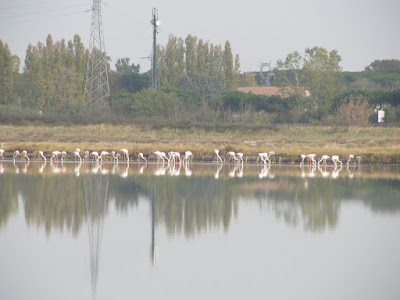I returned from another adventure that took me to The Italian and French Rivieras. I got an unexpected surprise while traveling from San Marino to Bologna. We stopped in a seaside town called Cervia where there is a salt flat. The salt here is used at the Vatican and is known as the "Pope's Salt". It is considered a sweet salt, not because it is sweet, but because it lacks a bitterness that other salts posses. As we were getting a talk on how they produce this special salt, I noticed some flamingos coming in for a landing in the distance. I walked quickly down the dirt walkway to get as close as I could without scaring them off in order to get a few shots. I like the way the birds reflect in the water.
Flamingos usually stand on one leg while the other is tucked beneath their body. The reason for this behaviour is not fully understood. One theory is that standing on one leg allows the birds to conserve more body heat, given that they spend a significant amount of time wading in cold water.[17] However, the behaviour also takes place in warm water and is also observed in birds that do not typically stand in water. An alternative theory is that standing on one leg reduces the energy expenditure for producing muscular effort to stand and balance on one leg. A study on cadavers showed that the one-legged pose could be held without any muscle activity, while living flamingos demonstrate substantially less body sway in a one-legged posture.[18] As well as standing in the water, flamingos may stamp their webbed feet in the mud to stir up food from the bottom.[19]
Flamingos are capable flyers and flamingos in captivity often require wing clipping to prevent escape.Young flamingos hatch with greyish reddish plumage, but adults range from light pink to bright red due to aqueous bacteria and beta-Carotene obtained from their food supply. A well-fed, healthy flamingo is more vibrantly colored and thus a more desirable mate; a white or pale flamingo, however, is usually unhealthy or malnourished. Captive flamingos are a notable exception; they may turn a pale pink if they are not fed carotene at levels comparable to the wild
Flamingos usually stand on one leg while the other is tucked beneath their body. The reason for this behaviour is not fully understood. One theory is that standing on one leg allows the birds to conserve more body heat, given that they spend a significant amount of time wading in cold water.[17] However, the behaviour also takes place in warm water and is also observed in birds that do not typically stand in water. An alternative theory is that standing on one leg reduces the energy expenditure for producing muscular effort to stand and balance on one leg. A study on cadavers showed that the one-legged pose could be held without any muscle activity, while living flamingos demonstrate substantially less body sway in a one-legged posture.[18] As well as standing in the water, flamingos may stamp their webbed feet in the mud to stir up food from the bottom.[19]
Flamingos are capable flyers and flamingos in captivity often require wing clipping to prevent escape.Young flamingos hatch with greyish reddish plumage, but adults range from light pink to bright red due to aqueous bacteria and beta-Carotene obtained from their food supply. A well-fed, healthy flamingo is more vibrantly colored and thus a more desirable mate; a white or pale flamingo, however, is usually unhealthy or malnourished. Captive flamingos are a notable exception; they may turn a pale pink if they are not fed carotene at levels comparable to the wild

No comments:
Post a Comment